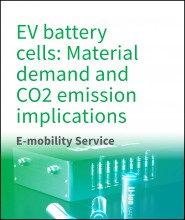
EV battery cells: Material demand and CO2 emission implications
This report provides an in-depth analysis of the global demand for EV battery raw materials, cathode and anode active materials. The report also takes a detailed look at the CO2 emissions associated with battery manufacturing.
Although battery electric vehicles (BEVs) have zero tailpipe emissions, they are are not fully emissions free. For EVs to be called completely emissions free, the industry needs to reduce the level of CO2 emitted during the manufactguring of EVs, which currently is higher than emissions from the manufacturing of conventional internal combustion engine (ICE) vehicles.
Manufacturing of lithium-ion (Li-ion) batteries is the biggest contributor across all the stages of EV production. Even in battery production, there are varying levels of emissions associated with each subprocess, such as material mining, refining, cathode and anode production, and module, battery pack assembly and also logistics. The report takes an in-depth look at the various processes involved in battery manufacturing and analyzes the Scope 1, Scope 2 and Scope 3 emissions related to these processes.
The report also assesses the demand for cathode active material (CAM), anode active material (AAM) and various primary materials used in battery manufacturing, including lithium, cobalt, nickel and manganese.





